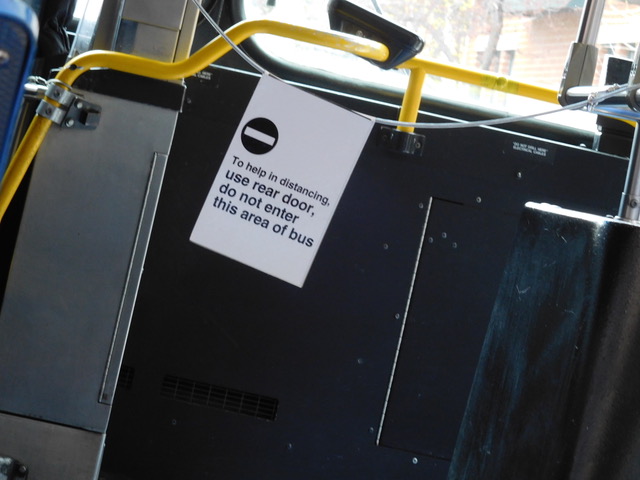On April 9 the CTA announced that it was going to require rear-door bus boarding, weeks after peer transit systems, in order to lower the risk of COVID-19 exposure for drivers and reduce queuing by customers. Part of the explanation for the delay was that, unlike other cities that simply waived fares to enable rear boarding, the CTA was planning to install Ventra card readers at the back door of all buses, and that strategy required extra preparation time.
The CTA told Streetsblog that bus fares would temporarily be free while it installed the card readers on all of its roughly 1,800 vehicles. As soon as entire lines were outfitted, passengers would be required to start paying again on that line. According to spokesman Brian Steele, that approach, as opposed to waiving fares for the entire time rear-boarding was in effect, would reduce revenue loss for a system that had seen ridership plummet by about 80 percent overall during the pandemic, and would also discourage non-essential transit trips. He expected that equipping the entire bus fleet would take only a few weeks.
One potential perk of the plan to install card readers on all buses was that it raised the possibility of introducing all-door boarding systemwide after the crisis was over. The transit agency was already planning to test all-door boarding on two bus lines, the J14 Jeffery Jump and the #192 University of Chicago Hospitals Express, with rear card readers this year as a strategy to reduce “dwell time” at stops.
But, as they say, the best-laid plans of mice and men often go awry. On Monday, about ten weeks after rear boarding started, the CTA resumed charging fares on the entire bus system, and reverted to requiring front boarding. But Steele revealed last week that payment was never required while rear boarding was in effect because only "a couple dozen" buses were ever equipped with card readers.
Steele said that the CTA decided the time was right to return to front boarding based on several factors. Many peer transit agencies have returned to front boarding and charging fares again. He said CTA drivers are currently well-equipped with masks, gloves, and hand-sanitizer, face shield and and goggles are also available to them, and all buses in use have a plexiglass shield to protect operators.
Since May 1, the state of Illinois has required transit customers to wear masks or other face coverings. Bus drivers have the option to run express when regular buses reach 15 riders or accordion buses have 22 passengers. And the transit system recently introduced a Ridership Information Dashboard that tells customers which bus runs have experienced crowding so they can plan accordingly.
The decision to revert to front boarding was made in conjunction with Amalgamated Transit Union Local 241, which represents CTA operators, Steele said. As part of the deal, the transit agency is now requiring passengers to stand father back from the from the driver than previously required during the pandemic.

Steele didn't seem overly concerned about a major backlash from passengers who have gotten used to riding buses for free but now have to pay. "While it's certainly possible we'll get some complaints, we do think that most people understand that as we're reopening the city, things are starting to get back to normal.
So why did the plan to put rear-door card readers on all the buses turn out to be such a flop? "The process of installing them is a bit involved," Steele responded, adding, "We knew rear-door boarding would be a temporary implementation."
We can add systemwide rear-door fare card readers to the list of initiatives that could have potentially sped up buses that the CTA said it was going to do, but never got around to completing. Another example of that was prepaid boarding on the downtown Loop Link express bus corridor. That time-saving feature was originally supposed to be included when Loop Link debuted in late 2015, but the agency ultimately decided not to implement it, which is a factor in why the corridor has seen only minor bus time improvements.
Oh well, hopefully the CTA will actually follow through on the plan for all-door boarding on the J14 and #192 this year. And if that pilot is successful, perhaps the agency will finally opt to install rear-door card readers on the entire fleet. Cities like New York and San Francisco have had all-door boarding for years, so that would help drag CTA bus service into the 21st Century.





